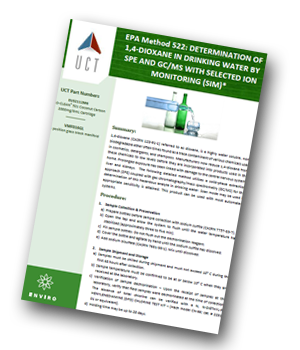UCT has produced an application note describing an SPE approach coupled with GC/MS for the determination of the hazardous analyte, 1,4-dioxane in drinking water.
 Summary
Summary
1,4-dioxane, referred to as dioxane, is a highly water soluble, non-biodegradable ether often times found as a trace contaminant of various chemicals used in cosmetics, detergents and shampoos. Prolonged exposure has been linked with damage to the central nervous system, liver and kidneys. The following detailed method utilizes a solid-phase extraction approach (SPE) coupled with gas chromatography/mass spectrometry (GC/MS) for the determination of this hazardous analyte in drinking water. Scan mode may be used if appropriate sensitivity is attained. This product can be used with most automated systems.
Procedure
Detailed step-by-step instructions are provided under the following headings:
- Sample Collection & Preservation
- Sample Shipment and Storage
- Interferences
- Safety
- Sample Preparation Procedure - Option 1 (100-500 mL samples)
Instrument and Conditions
These are given in the application note. Please note that any type of mass spectrometer may be used (i.e., quadrupole, ion trap, time of flight etc.), although the SIM option may not provide enhanced sensitivity or be an available option on all instruments.




